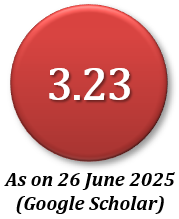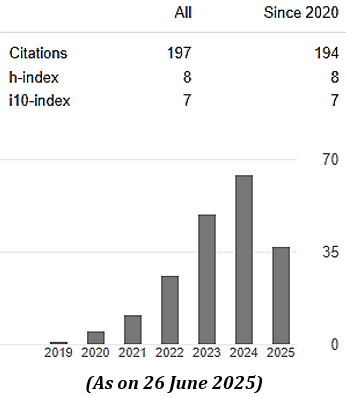Design of an Optimum Massive MIMO FSO System and Analysis of its Performance in Different Weather Conditions
Abstract
This aim of this work is to propose a massive MIMO FSO system with optimum design parameters and analyze its performance in various turbulent weather conditions by simulating the model in Optisystem . In recent years, the need for high speed data transfer for real time communication has become a necessity. Implementation of massive MIMO system has already gained remarkable achievement using the conventional RF transmission system. Although it is very much efficient in its application, it has some problems, such as licensing restrictions, bandwidth depletion, fragmentation. In this respect, Free space optics (FSO) is an efficient method for high speed data transfer as it does not have above limitations. Different researches conducted using MIMO FSO models have shown promising results. The use of massive MIMO system (more than array of antennas) will enhance data rate further. In this research work, an optimum massive MIMO FSO system has been designed with array of antennas. The performance of this system is analyzed in different weather conditions and compared with that of system. The analysis of performance is done by power penalty and receiver sensitivity plots. A significant transmission range and an optimum performance is obtained by using this system at a data rate of Gbps. However, data transmission rate can be much more enhanced in this system at the cost of reduced performance and a shorter transmission range.
Downloads
References
Albreem, M. A., Juntti, M., & Shahabuddin, S. (2019). Massive MIMO detection techniques: A survey. IEEE Communications Surveys & Tutorials, 21(4), 3109-3132. DOI: 10.1109/comst.2019.2935810
Anandkumar, D., & Sangeetha, R. G. (2020). A survey on performance enhancement in free space optical communication system through channel models and modulation techniques. Optical and Quantum Electronics, 53(1). DOI: 10.1007/s11082-020-02629-6
Badar, N., & Jha, R. K. (2017). Performance comparison of various modulation schemes over free space optical (FSO) link employing Gamma–Gamma fading model. Optical and Quantum Electronics, 49(5). DOI: 10.1007/s11082-017-1025-4
Naboulsi, M. A., Sizun, H., & Fornel, F.D. (2004). Fog attenuation prediction for optical and infrared waves. Optical Engineering, 43, 319-329.
Bhatnagar, M. R., & Ghassemlooy, Z. (2015, June). Performance evaluation of FSO MIMO links in Gamma-Gamma fading with pointing errors. In 2015 IEEE International Conference on Communications (ICC). (pp. 5084-5090).
Chatti, I., Baklouti, F., Chekir, F., & Attia, R. (2019). Comparative analysis of MIMO-based FSO and MIMO-based MGDM communications. Optical Review, 26(6), 631-643. DOI: 10.1007/s10043-019-00537-z
Chauhan, A., Kumari, A., Meena, P., & Meena, S. K. (2021, June). Performance Analysis of Optical Communication System for Various Filtering Operations Using MIMO FSO System under Fog Condition. In 2021 International Conference on Intelligent Technologies (CONIT). (pp. 1-5).
Dubey, A., & Singh, H. (2020, July). Performance Analysis of MIMO-FSO communication link with Hybrid Modulation. In 2020 7th International Conference on Smart Structures and Systems (ICSSS). (pp. 1-6).
El-Mashade, M., Aly, M., & Toeima, A. (2015). Performance evaluation of FSO system with MIMO technique in different operating environments. Physical Science International Journal, 7(1), 33-48. DOI:10.9734/PSIJ/2015/17212
Israr, A., Israr, A., Khan, F., & Khan, F. (2019). Optimal modulation technique for MIMO FSO link. Wireless Personal Communications, 109(2), 695-714. DOI:10.1007/s11277-019-06586-6
Jarangal, E., & Dhawan, D. (2018). Comparison of channel models based on Atmospheric turbulences of FSO system-A Review. International Journal of Research in Electronics and Computer Engineering, 6(1), 282-286.
Khwandah, S. A., Cosmas, J. P., Lazaridis, P. I., Zaharis, Z. D., & Chochliouros, I. P. (2021). Massive MIMO Systems for 5G Communications. Wireless Personal Communications, 1-15. DOI: 10.1007/s11277-021-08550-9
Kumar, N., & Khandelwal, V. (2019, March). Simulation of MIMO-FSO System with Gamma-Gamma Fading under Different Atmospheric Turbulence Conditions. In 2019 International Conference on Signal Processing and Communication (ICSC). (pp. 117-124).
Lu, L., Li, G. Y., Swindlehurst, A. L., Ashikhmin, A., & Zhang, R. (2014). An overview of massive MIMO: Benefits and challenges. IEEE Journal of Selected Topics in Signal Processing, 8(5), 742-758. DOI: 10.1109/jstsp.2014.2317671
Mansour, A., Mesleh, R., & Abaza, M. (2017). New challenges in wireless and free space optical communications. Optics and Lasers in Engineering, 89, 95-108. DOI: 10.1016/j.optlaseng.2016.03.027
Sangeetha, A., Sharma, N., & Deb, I. (2019). Feasibility evaluation of MIMO based FSO links. Journal of Communications, 14(3), 187-193. DOI: 10.12720/jcm.14.3.187-193
Thandapani, K., Gopalswamy, M., Jagarlamudi, S., & Sriram, N. B. (2021). Performance analysis of WDM free space optics transmission system using MIMO technique under various atmospheric conditions. Journal of Optical Communications. DOI:10.1515/joc-2021-0038
Tsai, C., Wong, K., & Li, W. (2018). Experimental results of the multi-Gbps smartphone with 20 multi-input multi-output (MIMO) antennas in the 20x12 MIMO operation. Microwave and Optical Technology Letters, 60(8), 2001-2010. DOI:10.1002/mop.31289
Zhang, Y., Wang, P., Guo, L., Wang, W., & Tian, H. (2017). Performance analysis of an OAM multiplexing-based MIMO FSO system over atmospheric turbulence using space-time coding with channel estimation. Optics express, 25(17), 19995-20011.
MIJST follows the open access policy.

This work is licensed under a Creative Commons Attribution-NonCommercial 4.0 International License. This allows anyone to copy, share, distribute, and modify the work for non-commercial purposes, where the original work and source should be properly credited.
















